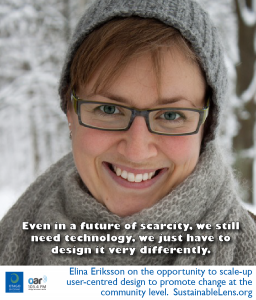Even in a future of scarcity, we still need technology, we just have to design it very differently.
Dr Elina Eriksson is interested in issues of usablity and user-centred design to promote change; both organizational change and change in individual behaviour.
Elina has multiple affiliations at KTH Royal Institute of Technology. She is in the School of Computer Science and Communication (CSC), the Department of Media Technology and Interaction Design (MID) and in research groups Green Leap and the Centre for Sustainable Communications (CESC).
Talking points
I realised quite early on that I don’t only want to work in computer science in programming, but I also want to get close to people and change stuff – so Human Computer Interaction became my major.
There is definitely a gender issue in how computer science portrays itself.
The Brundtland definition is talked about but it’s not really operationable.
The environmental aspects to sustainability are clearly important, with climate change, but I also feel very strongly for the social side of sustainability.
Circles within circles, we have to live within the bound of our earth.
Sometimes I think we are not good enough at reflecting on what we are doing and why. We can get so enthusiastic about new technology that we don’t really look back at what we are doing.
To create smart sustainable cities we need a bottom up view – what practices are making a difference and how can we help these practices through infrastructure?
Sustainability needs us to work on several different levels at the same time. Both at the policy legislation levels, and to change social norms – the culture.
For HCI this means a focus on norm-critical design. Technology can help people reflect more on their own practices.
HCI has such a suite of methods for helping improve work practices, now is the time to scale that up to the community – to smart cities.
Students report a cognitive dissonance, on one hand they are taught to develop new cool Apps, and on the other we come with our Sustainability course and tell them that this might not be the best way of working.
We focus on predicaments rather than problems. Problems are things we can solve, whereas predicament might be situations that are not solvable.
You have to find ways to work with a predicament, but there might not be one single solution.
We think it is important to be honest with students, that we are standing on the brink.
We try to find a balance between facts and values.
We can’t require them to have a particular value, but we can show…that as soon as we talk about the future, it is no longer a fact based science, it’s about values – what kind of future would we like to have.
ICT is interwoven with everything we do today in society, how much ICT is involved in efficiency, how much our norms and beliefs and culture is based on what we meet in the media
We play a discussion based board game – Gaming in Sustainability through Communication.
(Challenge) integrate sustainability into programme.
As long as the main goal of our education is forcing our students to work in an unsustainable manner, we will never reach a sustainable future.
How can we reach a sustainable future if we still have a consumer society?
Technology is a problem, but it can also solve things, dematerialise and make processes more efficient.
The fundamental problem of working with sustainability – it’s such a big system to change.
Related
Daniel Pargman

